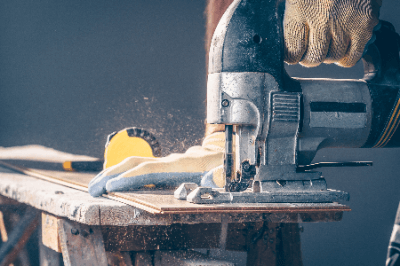What Is a Jig Saw?

A jig saw is a tool that cuts materials by moving a thin blade.
Since it is electrically operated, it can cut materials more easily than a saw. In addition to cutting in straight lines, it is also possible to cut in curved lines by changing the blade.
The blade used depends on the material to be cut out. Depending on the blade, a wide range of materials can be cut, from wood to plastic. Although the main purpose of the jig saw is to cut out materials, it can also be used for hollowing out materials by moving the jig saw from the hole cut out by the drill.
Uses of Jig Saws
Jig saws are widely used in DIY projects. When assembling furniture by yourself, you need to cut out the material you have purchased into the expected shape. While straight cuts can be made with a saw, curved cuts are difficult. Also, saws require direct hand movement, which is physically demanding.
With a jig saw, it is possible to cut out various shapes easily. However, there are some disadvantages, such as noisy operation and flying chips, so it is important to consider the operating environment.
Principle of Jig Saws
Jig saws cut objects because of the movement of the blade. The blade moves up and down in fine increments to cut materials. The shape of the blade varies depending on the material to be cut.
1. For Wood
This is the most commonly used jig saw. Like saws, it features a large blade. There are two types of jigsaws for wood: one for high-speed cutting and the other for finishing. The blade of the high-speed cutting type is larger than that of the normal type so that it can cut faster. For finishing, the blades are finer in order to finish the cut surface cleanly.
2. For Metal
Compared to wood, this type of jig saw has many finer blades. Metal is harder than wood, so it is easier to apply force to the blade. By using many fine blades, the force is dispersed and the burden on the blade is reduced.
3. For Plastic
Plastic is less sensitive to heat than wood or metal. Therefore, plastic is a material that tends to melt due to friction during cutting, resulting in burrs. To prevent burrs from occurring, the blade is characterized by its gently curved, wave-like shape.
How to Select a Jig Saw
There are many types of jig saw. Therefore, care should be taken when selecting a jigsaw to avoid purchasing an unintended product. When selecting a jig saw, consider the following points:
1. Support Functions
A product with numerous strokes and a wide width is recommended for fast and accurate cutting. There are also products with supports that enable straight cutting. Since support functions vary depending on the model and manufacturer, check which functions are provided before purchasing.
2. Orbital Function
The orbital function is a function that allows the blade to move back and forth as well as up and down. The more it moves back and forth, the faster it can cut.
3. Blade Replacement System
We recommend the one-touch type model for easy blade replacement, as it also improves work efficiency. Other than the one-touch type, products such as screw-fastening type are also available.
Other Information on Jigsaws
How to Use a Jig Saw
Jig saw blades are electrically operated, making it easy to cut wood, plastic, and other materials. On the other hand, it is a very dangerous tool that can cause personal injury if not used correctly.
The basic instructions for using a jig saw are as follows:
- Fasten the jig saw to the workbench with a clamp or similar device to prevent the material from moving due to the vibration of the jig saw.
- Draw a guideline at the point to be cut.
- Turn on the jig saw and run it dry.
- After confirming that the blade is working properly, insert the blade into the material at the point on the guideline.
- While looking at the cutting surface from directly above, advance the blade along the guideline.
It is important to read the above instructions and the product manual carefully before using. Also, make sure that the base of the jig saw body is in close contact with the material when cutting. Pressing the jig saw against the material while cutting will reduce the flapping of the material.